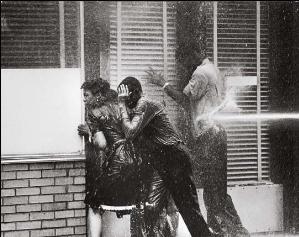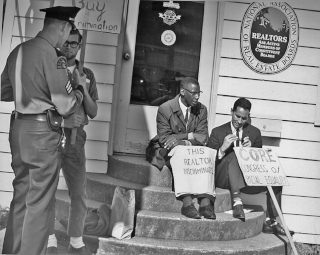Related Research Articles

The civil rights movement was a social movement and campaign in the United States from 1954 to 1968 that aimed to abolish legalized racial segregation, discrimination, and disenfranchisement in the country, which was most commonly employed against African Americans. The movement had origins in the Reconstruction era during the late 19th century, and had modern roots in the 1940s. After years of direct actions and grassroots protests, the movement made its largest legislative and judicial gains during the 1960s. The movement's major nonviolent resistance and civil disobedience campaigns eventually secured new protections in federal law for the civil rights of all Americans.

The Congress of Racial Equality (CORE) is an African-American civil rights organization in the United States that played a pivotal role for African Americans in the civil rights movement. Founded in 1942, its stated mission is "to bring about equality for all people regardless of race, creed, sex, age, disability, sexual orientation, religion or ethnic background." To combat discriminatory policies regarding interstate travel, CORE participated in Freedom Rides as college students boarded Greyhound Buses headed for the Deep South. As the influence of the organization grew, so did the number of chapters, eventually expanding all over the country. Despite CORE remaining an active part of the fight for change, some people have noted the lack of organization and functional leadership has led to a decline of participation in social justice.

James Morris Lawson Jr. was an American activist and university professor. He was a leading theoretician and tactician of nonviolence within the Civil Rights Movement. During the 1960s, he served as a mentor to the Nashville Student Movement and the Student Nonviolent Coordinating Committee. He was expelled from Vanderbilt University for his civil rights activism in 1960, and later served as a pastor in Los Angeles for 25 years.

The Southern Christian Leadership Conference (SCLC) is an African-American civil rights organization based in Atlanta, Georgia. SCLC is closely associated with its first president, Martin Luther King Jr., who had a large role in the American civil rights movement.
Radical Women (RW) is an American socialist feminist grassroots activist organization affiliated with the Freedom Socialist Party. It has branches in Seattle, Washington, and Melbourne, Australia.

Edgar Daniel Nixon, known as E. D. Nixon, was an American civil rights leader and union organizer in Alabama who played a crucial role in organizing the landmark Montgomery bus boycott there in 1955. The boycott highlighted the issues of segregation in the South, was upheld for more than a year by black residents, and nearly brought the city-owned bus system to bankruptcy. It ended in December 1956, after the United States Supreme Court ruled in the related case, Browder v. Gayle (1956), that the local and state laws were unconstitutional, and ordered the state to end bus segregation.

Avery Caesar Alexander was an American reverend, civil rights leader and politician. He graduated from Union Baptist Theological Seminary and was ordained into the Baptist ministry in 1944. He was elected to the Louisiana House of Representatives as a Democrat in 1975 and served in that office until his death.

The Birmingham campaign, also known as the Birmingham movement or Birmingham confrontation, was an American movement organized in early 1963 by the Southern Christian Leadership Conference (SCLC) to bring attention to the integration efforts of African Americans in Birmingham, Alabama.
The Women's Political Council (WPC), founded in Montgomery, Alabama, was an organization that formed in 1946 that was an early force active in the civil rights movement that was formed to address the racial issues in the city. Members included Mary Fair Burks, Jo Ann Robinson, Maude Ballou, Irene West, Thelma Glass, and Euretta Adair.
The civil rights movement in Omaha, Nebraska, has roots that extend back until at least 1912. With a history of racial tension that starts before the founding of the city, Omaha has been the home of numerous overt efforts related to securing civil rights for African Americans since at least the 1870s.

Johnnie Rebecca Daniels Carr was a leader in the Civil Rights Movement in the United States from 1955 until her death.
The Tyree Scott Freedom School is an educational program in Seattle, Washington, with a curriculum on social justice issues and anti-racist community organizing in Seattle. The project also holds a monthly gathering of anti-racist educators, whose goal is to end institutional racism in the education system.

The Seattle movement was part of the wider Civil Rights Movement, taking place in Seattle, Washington in the 1960s.

Samuel Woodrow Williams was a Baptist minister, professor of philosophy and religion, and Civil Rights activist. Williams was born on February 12, 1912, in Sparkman then grew up in Chicot County, Arkansas. An African American, Williams attended Morehouse College where he received his bachelor's degree in philosophy and later attended Howard University earning his master's degree in divinity.
The United Freedom Movement (UFM) was a coalition of about 60 African American civic, religious, cultural, and other groups founded in June 1963 to oppose legal and institutional racism in public schools, employment, housing, and other areas. The organization's founding marked a turning point in Cleveland during the civil rights movement by turning away from behind-the-scenes negotiation and toward public protest. It had successes in the area of employment and public school desegregation. It dissolved in 1966.
George T. Raymond was an American civil rights leader from Pennsylvania who served as president of the Chester, Pennsylvania, branch of the National Association for the Advancement of Colored People (NAACP) from 1942 to 1977. He was integral in the desegregation of businesses, public housing and schools in Chester and co-led the Chester school protests in 1964 which made Chester a key battleground in the civil rights movement.

The New York City school boycott, also referred to as Freedom Day, was a large-scale boycott and protest against segregation in the New York City public school system which took place on February 3, 1964. Students and teachers walked out to highlight the deplorable conditions at public schools in the city, and demonstrators held rallies demanding school integration. It has been described as the largest civil rights protest of the 1960s, involving nearly half a million participants.
Milton Arthur Galamison was a Presbyterian minister who served in Brooklyn, New York. As a community activist, he championed integration and education reform in the New York City public school system, and organized two school boycotts.
The Chester school protests were a series of demonstrations that occurred from November 1963 through April 1964 in Chester, Pennsylvania. The demonstrations aimed to end the de facto segregation of Chester public schools that persisted after the 1954 Supreme Court case Brown v. The Board of Education of Topeka. The racial unrest and civil rights protests were led by Stanley Branche of the Committee for Freedom Now (CFFN) and George Raymond of the National Association for the Advancement of Colored Persons (NAACP).
Reverend Cecil Augustus Ivory was a Presbyterian minister, disability rights activist and sit-in leader during the Civil rights movement.
References
- 1 2 Goodnow, Cecelia (2002-02-06), "City made great strides during the civil rights movement", Seattle Post-Intelligencer, retrieved 2009-02-07
- ↑ Clarck, Brooke. Seattle Civil Rights and Labor History Homepage. "The Seattle School Boycott of 1966." 2005. 24 June 2006.
- ↑ Clarck, Brooke. Seattle Civil Rights and Labor History Homepage. "The Seattle School Boycott of 1966: Identifying the Problem." 2005. 24 June 2006.
- 1 2 3 Clarck, Brooke. Seattle Civil Rights and Labor History Homepage. "The Seattle School Boycott of 1966: Planning for the Boycott." 2005. 24 June 2006.
- ↑ Clarck, Brooke. Seattle Civil Rights and Labor History Homepage. "The Seattle School Boycott of 1966: Support and Opposition for the Boycott." 2005. 24 June 2006.
- 1 2 Clarck, Brooke. Seattle Civil Rights and Labor History Homepage. "The Seattle School Boycott of 1966: The Boycott." 2005. 24 June 2006.
- ↑ Clarck, Brooke. Seattle Civil Rights and Labor History Homepage. "The Seattle School Boycott of 1966: The Aftermath." 2005. 24 June 2006.